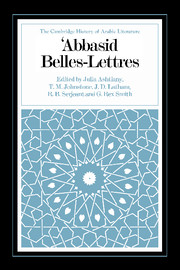Book contents
- Frontmatter
- The ʿAbbasid Caliphate: a historical introduction
- 1 Adab and the concept of belles-lettres
- 2 Shuʿūbiyyah in Arabic literature
- 3 Ibn al-Muqaffaʿ and early ʿAbbasid prose
- 4 Al-Jāḥiẓ
- 5 Al-Ṣaḥib Ibn ʿAbbād
- 6 Abū Ḥayyān al-Tawḥīdī
- 7 Al-Hamadhānī, al-Ḥarīrī and the maqāmāt genre
- 8 Fables and legends
- 9 ʿAbbasid poetry and its antecedents
- 10 Hunting poetry (ṭardiyjāt)
- 11 Political poetry
- 12 Love poetry (ghazal)
- 13 Wine poetry (khamriyyāt)
- 14 Mystical poetry
- 15 Ascetic poetry (zuhdiyyāt)
- 16 Bashshār b. Burd, Abū ʾl-ʿAtāhiyah and Abū Nuwās
- 17 Al-Mutanabbī
- 18 Abū Firās al-Ḥamdānī
- 19 Abū ʾl-ʿAlāʾ al-Maʿarrī
- 20 Literary criticism
- 21 Ibn al-Muʿtazz and Kitāb al-Badīʿ
- 22 Regional literature: Egypt
- 23 Regional literature: the Yemen
- Appendix: Table of metres
- Bibliography
- Index
13 - Wine poetry (khamriyyāt)
Published online by Cambridge University Press: 28 May 2012
- Frontmatter
- The ʿAbbasid Caliphate: a historical introduction
- 1 Adab and the concept of belles-lettres
- 2 Shuʿūbiyyah in Arabic literature
- 3 Ibn al-Muqaffaʿ and early ʿAbbasid prose
- 4 Al-Jāḥiẓ
- 5 Al-Ṣaḥib Ibn ʿAbbād
- 6 Abū Ḥayyān al-Tawḥīdī
- 7 Al-Hamadhānī, al-Ḥarīrī and the maqāmāt genre
- 8 Fables and legends
- 9 ʿAbbasid poetry and its antecedents
- 10 Hunting poetry (ṭardiyjāt)
- 11 Political poetry
- 12 Love poetry (ghazal)
- 13 Wine poetry (khamriyyāt)
- 14 Mystical poetry
- 15 Ascetic poetry (zuhdiyyāt)
- 16 Bashshār b. Burd, Abū ʾl-ʿAtāhiyah and Abū Nuwās
- 17 Al-Mutanabbī
- 18 Abū Firās al-Ḥamdānī
- 19 Abū ʾl-ʿAlāʾ al-Maʿarrī
- 20 Literary criticism
- 21 Ibn al-Muʿtazz and Kitāb al-Badīʿ
- 22 Regional literature: Egypt
- 23 Regional literature: the Yemen
- Appendix: Table of metres
- Bibliography
- Index
Summary
Wine poetry is found in all periods of Arabic literature, though with fluctuating frequency, and variation between incidental references and pieces devoted wholly to wine; in some periods, the theme of wine dominated poetic production. Prose works devoted to wine are also found, but far less frequently; two typical examples may be cited. In North Africa, at the turn of the fourth–fifth/tenth–eleventh centuries, Abū Isḥāq Ibrāhām b. al-Qāsim, known as al-Raqīq al-Nadīm, wrote Quṭb al-surūr ft awṣaj alkhumūr (“The Acme of Joy in Praise of Wine”), an encyclopaedic work discussing the etiquette of wine and wine-parties, wine's remedial qualities, how to profit from its blends, textual citations dealing with it, legal arguments centred on it, entertaining stories about it, and an appendix of poetical references. In the East, at the beginning of the ninth/fifteenth century, Muḥammad b. Ḥasan b. ʿUthmān al-Nawājī wrote Ḥalbat al- Kumayt (“The Bay's Racetrack”; a punning allusion to the fact that kumayt, “bay-coloured”, is a conventional epithet for both horses and wine), which discusses the origins of wine, its names, appearance, advantages and properties according to learned writers, tales about persons accused of addiction to it, its qualities, both material and moral, the correct behaviour for a drinking-partner or boon-companion (nadīm), how to offer wine and issue an invitation to a wine-party, and description of the wine-party and all its appurtenances – drinking-vessels, singing, instrumental music, candles, flowers and gardens.
- Type
- Chapter
- Information
- Abbasid Belles Lettres , pp. 219 - 234Publisher: Cambridge University PressPrint publication year: 1990



